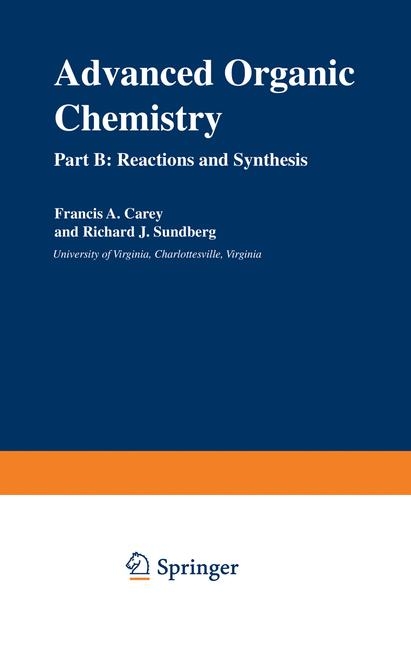
Advanced Organic Chemistry
Springer-Verlag New York Inc.
978-1-4615-8887-0 (ISBN)
- Titel ist leider vergriffen;
keine Neuauflage - Artikel merken
of Part B.- 1. Alkylation of Carbon via Enolates and Enamines.- 1.1. Generation of Carbon Nucleophiles by Proton Abstraction.- 1.2. Kinetic Versus Thermodynamic Control in Formation of Enolates.- 1.3. Other Means of Generating Enolates.- 1.4. Alkylations of Enolates.- 1.5. Generation and Alkylation of Dianions.- 1.6. Solvent Effects in Enolate Alkylations.- 1.7. Oxygen Versus Carbon as the Site of Alkylation.- 1.8. Alkylations of Aldehydes, Esters, Nitriles, and Nitro Compounds.- 1.9. The Nitrogen Analogs of Enols and Enolates-Enamine Alkylations.- 1.10. Alkylation of Carbon by Conjugate Addition.- General References.- Problems.- 2. Reactions of Nucleophilic Carbon Species with Carbonyl Groups.- 2.1. Aldol Condensation.- 2.2. Related Condensation Reactions.- 2.3. The Mannich Reaction.- 2.4. Acylation of Nucleophilic Carbon.- 2.5. The Wittig Reaction.- 2.6. Sulfur Ylides as Nucleophiles.- 2.7. Nucleophilic Addition-Cyclization.- General References.- Problems.- 3. Addition Reactions of Carbon-Carbon Multiple Bonds.- 3.1. Addition of Hydrogen.- 3.2. Addition of Hydrogen Halides.- 3.3. Hydration and Other Acid-Catalyzed Additions.- 3.4. Oxymercuration.- 3.5. Addition of Halogens to Olefins.- 3.6. Addition of Other Electrophilic Reagents.- 3.7. Electrophilic Substitution Alpha to Carbonyl Groups.- 3.8. Hydroboration.- 3.9. Additions to Allenes and Alkynes.- General References.- Problems.- 4. Reduction of Carbonyl and Other Functional Groups.- 4.1. Hydride-Transfer Reagents.- 4.2. Hydrogen-Atom Donors.- 4.3. Dissolving-Metal Reductions.- General References.- Problems.- 5. Organometallic Compounds.- 5.1. Organic Derivatives of Group I and II Metals.- 5.1.1. Preparation and Properties.- 5.1.2. Reactions.- 5.2. Organic Derivatives of Group IIb Metals.- 5.3. Organic Derivatives of Transition Metals.- 5.4. Catalysis of Rearrangements by Metal Ions and Complexes.- 5.5. Organometallic Compounds with ?-Bonding.- General References.- Problems.- 6. Cycloadditions and Unimolecular Rearrangements and Eliminations.- 6.1. Cycloaddition Reactions.- 6.1.1. Diels-Alder Reaction.- 6.1.2. Dipolar Cycloaddition Reactions.- 6.1.3. 2 + 2 Cycloadditions and Other Reactions Leading to Cyclobutanes.- 6.2. Photochemical Cycloadditions.- 6.3. SigmatropicRearrangements.- 6.4. Unimolecular Thermal Elimination Reactions.- 6.4.1. Cycloreversions and Related Eliminations.- 6.4.2. ?-Eliminations Involving Cyclic Transition States.- General References.- Problems.- 7. Aromatic Substitution Reactions.- 7.1. Electrophilic Aromatic Substitution.- 7.1.1. Nitration.- 7.1.2. Halogenation.- 7.1.3. Friedel-Crafts Alkylations and Acylations.- 7.1.4. Electrophilic Metalation.- 7.2. Nucleophilic Aromatic Substitution.- 7.2.1. Nucleophilic Aromatic Substitution via Diazonium Ions.- 7.2.2. Nucleophilic Aromatic Substitution by Addition-Elimination.- 7.2.3. Nucleophilic Aromatic Substitution by Elimination-Addition.- 7.2.4. Copper-Catalyzed Nucleophilic Aromatic Substitution.- 7.3. Substitutions Involving Aryl Free Radicals.- 7.4. Reactivity of Polycyclic Aromatics.- General References.- Problems.- 8. Reactions Involving Carbenes, Nitrenes, and Other Electron-Deficient Intermediates.- 8.1. Carbenes.- 8.1.1. Structure.- 8.1.2. Generation of Carbenes.- 8.1.3. Reactions.- 8.2. Nitrenes.- 8.3. Rearrangements of Electron-Deficient Intermediates.- 8.3.1. Migration to Carbon.- 8.3.2. Migration to Nitrogen.- 8.4. Fragmentation Reactions.- 8.5. Some Synthetically Useful Carbonium-Ion Reactions.- General References.- Problems.- 9. Oxidations.- 9.1. Oxidation of Alcohols to Aldehydes, Ketones, or Carboxylic Acids.- 9.1.1. Transition-Metal Oxidants.- 9.1.2. Oxygen, Ozone, and Peroxides.- 9.1.3. Other Oxidants.- 9.2. Addition of Oxygen at Carbon-Carbon Double Bonds.- 9.2.1. Transition-Metal Oxidants.- 9.2.2. Epoxides from Olefins and Peroxidic Reagents.- 9.3. Cleavage of Carbon-Carbon Double Bonds.- 9.3.1. Transition-Metal Oxidants.- 9.3.2. Ozonolysis.- 9.4. Selective Oxidative Cleavages at Other Functional Groups.- 9.4.1. Cleavage of Glycols.- 9.4.2. Oxidative Decarboxylation.- 9.5. Oxidations of Ketones and Aldehydes.- 9.5.1. Transition-Metal Oxidants.- 9.5.2. Oxidation of Ketones and Aldehydes by Peroxidic Compounds and Oxygen.- 9.5.3. Oxidations with Other Reagents.- 9.6. Allylic Oxidation of Olefins.- 9.6.1. Transition-Metal Oxidants.- 9.6.2. Oxygen, Ozone, and Peroxides.- 9.6.3. Other Oxidants.- 9.7. Oxidations at Unfunctionalized Carbon Atoms.- General References.- Problems.- 10. Multistep Syntheses.- 10.1. Protective Groups.- 10.1.1. Hydroxyl-Protecting Groups.- 10.1.2. Amino-Protecting Groups.- 10.1.3. Carbonyl-Protecting Groups.- 10.1.4. Carboxylic Acid Protecting Groups.- 10.2. Synthetic Equivalent Groups.- 10.3. Asymmetric Syntheses.- 10.4. Synthetic Strategy.- General References.- Problems.- 11. Synthesis of Macromolecules.- 11.1. Polymerization.- 11.1.1. Chain-Addition Polymerization.- 11.1.2. Step-Growth Polymerization.- 11.2. Peptide and Protein Synthesis.- 11.3. Nucleosides, Nucleotides, and Polynucleotides.- General References.- Problems.- References for Problems.
| Zusatzinfo | biography |
|---|---|
| Verlagsort | New York, NY |
| Sprache | englisch |
| Maße | 178 x 254 mm |
| Gewicht | 1031 g |
| Einbandart | Paperback |
| Themenwelt | Sachbuch/Ratgeber ► Natur / Technik ► Garten |
| Medizin / Pharmazie ► Pflege | |
| Medizin / Pharmazie ► Pharmazie ► PTA / PKA | |
| Naturwissenschaften ► Biologie ► Biochemie | |
| Naturwissenschaften ► Chemie ► Organische Chemie | |
| ISBN-10 | 1-4615-8887-1 / 1461588871 |
| ISBN-13 | 978-1-4615-8887-0 / 9781461588870 |
| Zustand | Neuware |
| Haben Sie eine Frage zum Produkt? |
aus dem Bereich


